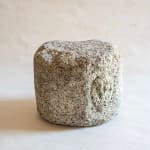





artisan's name unknown
The Mu-ho-To pagoda stone, Mid 14th Century
Stone
5 1/2"" x 7"
Further images
Mu-Ho-To pagodas commemorate the lives of the highest-ranking Zen monks. The leftmost stone is from the mid-section of a Mu-Ho-To pagoda. It was carved 700 years ago has has four...
Mu-Ho-To pagodas commemorate the lives of the highest-ranking Zen monks. The leftmost stone is from the mid-section of a Mu-Ho-To pagoda. It was carved 700 years ago has has four facets featuring Buddah carvings. The carvings emit a powerful and calming aura celebrating the monk’s life.
In traditional Mu-Ho-To pagodas, the middle part typically showcased a hexagonal shape, much like this one. However, this piece is different. It has carvings of Buddha on every other side, which is rare. What is even more rare is that the carvings remain. The preservation of the carvings stands as an awe-inspiring testament to the monk.
Japanese author Saisei Muro said, “Stone is reticent. It only talks to open and sophisticated minds.” (By “stone,” Muro meant ancient carved stones.)
In traditional Mu-Ho-To pagodas, the middle part typically showcased a hexagonal shape, much like this one. However, this piece is different. It has carvings of Buddha on every other side, which is rare. What is even more rare is that the carvings remain. The preservation of the carvings stands as an awe-inspiring testament to the monk.
Japanese author Saisei Muro said, “Stone is reticent. It only talks to open and sophisticated minds.” (By “stone,” Muro meant ancient carved stones.)
Signup for our Newsletter
You will receive two emails a month from us. One introduces artworks and design works from Kyoto's hidden sources and the other is stories from Misako, sharing insights into Japanese culture.
* denotes required fields
为了回应您的查询,我们将根据我们的隐私政策处理您提供的个人数据。





